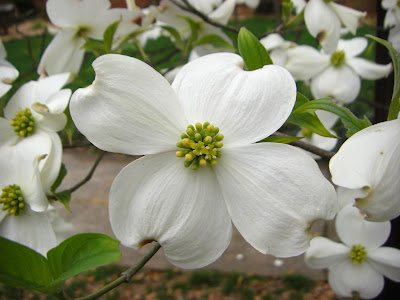 |
| What is dogwood? |
Plants from the dogwood family are highly conspicuous over the winter period due to their brightly coloured stems. Different varieties have different stems colours - most noticeable on the new growth, and can be used to great effect in winter and early spring planting schemes when seasonal colour is extremely limited. Of course, there are a number of small, choice, flowering trees
The botanical name for dogwood is Cornus and is a genus of about 30-60 species of woody plants in the family Cornaceae. The genus name 'Cornus' comes from the Latin word for horn, as in the hard horn of an animal, and denote the hardness of its wood.
Dense and fine-grained, dogwood timber is extremely dense and is highly prized for making loom shuttles, tool handles, roller skates and other small items that require a very hard and strong wood.
Although it's denseness makes it tough for woodworking, some artisans favour dogwood for small projects such as walking canes, longbows, mountain dulcimers and fine inlays.
Believe it or not, dogwood twigs were used by early American pioneers to brush their teeth! They would peel off the bark, bite the twig and then scrub their teeth.
Most dogwoods are deciduous trees or shrubs, but a few species are nearly herbaceous perennial sub-shrubs, and a few of the woody species are in fact evergreen.
Several species have small heads of inconspicuous flowers surrounded by large, typically white petal-like bracts, while others have more open clusters of petal-bearing flowers.
The various species of dogwood are native throughout much of temperate Eurasia and North America, with China and Japan and the south-eastern United States particularly rich in native species.
Popular and sought after species include the common dogwood Cornus sanguinea of Eurasia, the widely cultivated flowering dogwood (Cornus florida) of eastern North America, the Pacific dogwood Cornus nuttallii of western North America, the Kousa dogwood Cornus kousa of eastern Asia, and two low-growing boreal species, the Canadian and Eurasian dwarf cornels (or bunchberries), Cornus canadensis and Cornus suecica respectively.
Where does the name Dogwood come from?
The name "dog-tree" entered the English vocabulary by 1548, and had been further transformed to 'dogwood' by 1614.
Once the name dogwood was commonplace to this species of tree, it soon acquired a secondary name as the Hound's Tree, while the fruits came to be known as dogberries or houndberries.
Another theory advances the view that "dogwood" was derived from the Old English dagwood, from the use of the slender stems of its very hard wood for making "dags" (daggers, skewers, and arrows).
For related articles click onto:
THE EVERGREEN CLEMATIS - Clematis armandii
WHAT IS DOGWOOD?
What is Horticulture?
WHAT IS A STUMPERY?
When and how should you prune back Lavender?
When to Plant Lavender?
 |
| Dogwood blooms |
Dense and fine-grained, dogwood timber is extremely dense and is highly prized for making loom shuttles, tool handles, roller skates and other small items that require a very hard and strong wood.
Although it's denseness makes it tough for woodworking, some artisans favour dogwood for small projects such as walking canes, longbows, mountain dulcimers and fine inlays.
Believe it or not, dogwood twigs were used by early American pioneers to brush their teeth! They would peel off the bark, bite the twig and then scrub their teeth.
 |
| Dogwood tree in full bloom |
Several species have small heads of inconspicuous flowers surrounded by large, typically white petal-like bracts, while others have more open clusters of petal-bearing flowers.
The various species of dogwood are native throughout much of temperate Eurasia and North America, with China and Japan and the south-eastern United States particularly rich in native species.
Popular and sought after species include the common dogwood Cornus sanguinea of Eurasia, the widely cultivated flowering dogwood (Cornus florida) of eastern North America, the Pacific dogwood Cornus nuttallii of western North America, the Kousa dogwood Cornus kousa of eastern Asia, and two low-growing boreal species, the Canadian and Eurasian dwarf cornels (or bunchberries), Cornus canadensis and Cornus suecica respectively.
Where does the name Dogwood come from?
 |
| Dogwood arrow |
Once the name dogwood was commonplace to this species of tree, it soon acquired a secondary name as the Hound's Tree, while the fruits came to be known as dogberries or houndberries.
Another theory advances the view that "dogwood" was derived from the Old English dagwood, from the use of the slender stems of its very hard wood for making "dags" (daggers, skewers, and arrows).
For related articles click onto:
THE EVERGREEN CLEMATIS - Clematis armandii
WHAT IS DOGWOOD?
What is Horticulture?
WHAT IS A STUMPERY?
When and how should you prune back Lavender?
When to Plant Lavender?







No comments:
Post a Comment